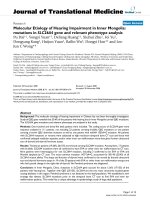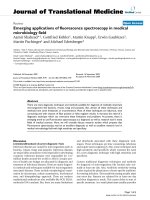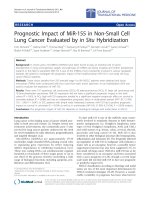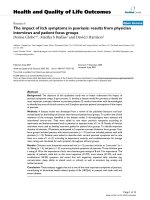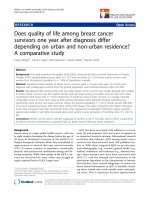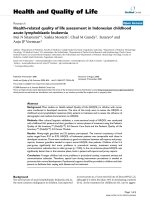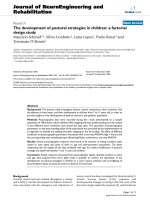báo cáo hóa học: " Health-related quality of life assessment in Indonesian childhood acute lymphoblastic leukemia" potx
Bạn đang xem bản rút gọn của tài liệu. Xem và tải ngay bản đầy đủ của tài liệu tại đây (226.61 KB, 8 trang )
BioMed Central
Page 1 of 8
(page number not for citation purposes)
Health and Quality of Life
Open Access
Research
Health-related quality of life assessment in Indonesian childhood
acute lymphoblastic leukemia
Mei N Sitaresmi*
1
, Saskia Mostert
2
, Chad M Gundy
3
, Sutaryo
4
and
Anjo JP Veerman
2
Address:
1
Department of Pediatrics, Faculty of Medicine, Gadjah Mada University, Yogyakarta, Indonesia,
2
Department of Pediatric Hematology-
Oncology, VU Medical Center, VU, Amsterdam, the Netherlands,
3
Department of Psycho-Social Research and Epidemiology, Dutch Cancer
Institute-Antoni van Leeuwenhoek Hospital, Amsterdam, the Netherlands and
4
Department of Pediatric Hematology-Oncology, Faculty of
Medicine, Gadjah Mada University, Yogyakarta, Indonesia
Email: Mei N Sitaresmi* - ; Saskia Mostert - ; Chad M Gundy - ;
Sutaryo - ; Anjo JP Veerman -
* Corresponding author
Abstract
Background: Most studies on Health-related Quality of Life (HRQOL) in children with cancer
were conducted in developed countries. The aims of this study were to assess the HRQOL in
childhood acute lymphoblastic leukemia (ALL) patients in Indonesia and to assess the influence of
demographic and medical characteristics on HRQOL.
Methods: After cultural linguistic validation, a cross-sectional study of HRQOL was conducted
with childhood ALL patients and their guardians in various phases of treatment using the Pediatric
Quality of Life Inventory™ (PedsQL™) 4.0 Generic Core Scale and the Pediatric Quality of Life
Inventory™ (PedsQL™) 3.0 Cancer Module.
Results: Ninety-eight guardians and 55 patients participated. The internal consistency of both
scales ranged from 0.57 to 0.92. HRQOL of Indonesian patients was comparable with those in
developed countries. There were moderate to good correlations between self-reports and proxy-
reports, however guardians tended to report worse HRQOL than patients. Children of the 2–5
year-group significantly had more problems in procedural anxiety, treatment anxiety and
communication subscales than in older groups (p < 0.05). In the non-intensive phase HRQOL was
significantly better than in the intensive phase, both in patient self-reports and proxy-reports.
Conclusion: Younger children had more problems in procedural anxiety, treatment anxiety and
communication subscales. Therefore, special care during intervention procedures is needed to
promote their normal development. Psychosocial support should be provided to children and their
parents to facilitate their coping with disease and its treatment.
Background
The survival rate of acute lymphoblastic leukaemia (ALL),
the most common malignancy in children, has improved
in recent years to a 5-year survival rate of about 80% [1,2],
although it is often less than 35% in developing countries
[3-6]. As the treatment for childhood ALL can be aggres-
Published: 9 November 2008
Health and Quality of Life Outcomes 2008, 6:96 doi:10.1186/1477-7525-6-96
Received: 10 August 2008
Accepted: 9 November 2008
This article is available from: />© 2008 Sitaresmi et al; licensee BioMed Central Ltd.
This is an Open Access article distributed under the terms of the Creative Commons Attribution License ( />),
which permits unrestricted use, distribution, and reproduction in any medium, provided the original work is properly cited.
Health and Quality of Life Outcomes 2008, 6:96 />Page 2 of 8
(page number not for citation purposes)
sive and associated with acute and long-term morbidity
due to side effects, it is important to not only look at the
survival but to analyze the health-related quality of life
(HRQOL) as well [2]. Implementing HRQOL measure-
ments in pediatric healthcare settings can improve com-
munication between patients and health care providers
(HCP), increase patient/parent satisfaction with HCP,
identify hidden morbidities, and assist in clinical deci-
sion-making [7,8].
HRQOL is defined as a multidimensional construct com-
posed of the patients' perceptions of the impact of disease
and treatment on his or her functioning in a variety of
aspects of life, including physical, psychological and
social health domains [8,9]. Pediatric patient self-reports
are considered to be the standard for measuring HRQOL,
however proxy reports may be the only available source of
data when children are too young, too cognitively
impaired or too sick to complete a HRQOL instrument
[10,11]. A generic HRQOL measurement instrument can
be used in a healthy population and enables standardized
comparisons between healthy children and children with
chronic health problems. However it cannot be used to
measure specific disease symptoms and treatment side
effects. A disease-specific instrument is unable to provide
comparisons with healthy children, but it is more sensi-
tive to measure clinical symptoms of diseases. Using both
a generic and specific diseases instrument is recom-
mended to achieve a more comprehensive evaluation of
the patients' HRQOL [8]. The Pediatric Quality of Life
Inventory (PedsQL™) 4.0 Generic Core Scales [12], and
the Pediatric Quality of Life Inventory™ (PedsQL) 3.0
Cancer Module [13] are considered to be very promising
HRQOL instruments for children and adolescents, inte-
grating generic core scales and disease-specific modules
into one measurement system. It is designed for pediatric
patients between the ages of 2 and 18 years, and available
in a patient self-report version designed for children/ado-
lescents and a proxy-report version for guardians [14-17].
Some studies found that there was correlation between
gender and socioeconomic status (SES) and health status
influence HRQOL [14,17]. Many studies assessed HRQOL
in childhood ALL patients in developed countries, but few
have been conducted in developing countries, where sup-
portive care for ALL patients is limited [18-21]. The aims
of this study were to assess the HRQOL in childhood acute
lymphoblastic leukemia (ALL) patients in Indonesia and
to assess the influence of demographic and medical char-
acteristics on HRQOL.
Methods
Setting
Indonesia is a multi-island state, and has a population of
approximately 220 million of whom 37% are children
under 15 years. A childhood leukemia incidence of 2.5 to
4.0 new cases per 100 000 children leads to an estimated
2000 to 3200 new childhood ALL cases each year [22].
Our study was conducted at the pediatric department of
Dr. Sardjito Hospital in Yogyakarta, Indonesia. Dr. Sard-
jito Hospital is a teaching hospital of the medical faculty
of the Gadjah Mada University, and a tertiary-care referral
hospital of the Yogyakarta and Central Java Provinces.
Annually aproximately 30–40 children are diagnosed
with ALL. The pediatric department consists of a clinic
(VIP, 1
st
, 2
nd
, and 3
rd
class) and a policlinic (VIP and gen-
eral).
Study design
After cultural linguistic validation, a cross-sectional study
was conducted with childhood ALL patients and their
guardians in various phases of treatment using the Pediat-
ric Quality of Life Inventory™ (PedsQL™) 4.0 Generic Core
Scale and the Pediatric Quality of Life Inventory™ (Ped-
sQL™) 3.0 Cancer Module. The cultural linguistic valida-
tion process consists of 3 steps: forward translation,
backward translation, and patient testing. In the first step,
the instruments were translated from English version to
Bahasa Indonesia version, and it was done independently
by two local professional translators, native Indonesia
speakers, and bilingual in English language. The second
step, the Bahasa Indonesia version was translated back to
English version and it was done independently by two
local professional translators, native English speakers, and
bilingual in Bahasa Indonesia language. In this step a
comparison between the backward version with the origi-
nal version was assessed in order to detect any misunder-
standings, mistranslations or inaccuracies in the
intermediary forward version of the questionnaire.
Finally, the translated questionnaire was tested in 5 cancer
families, both in children and their guardians, to deter-
mine whether the translation (instructions, items and
response choices) is acceptable, whether it is understood
in the way it is supposed to be, and whether the language
used is simple and appropriate. All PedsQL™ translations
were conducted in close ongoing collaboration with Mapi
Research Institute in Lyon, France and with Dr. James W.
Varni.
Participants were childhood ALL patients who were hos-
pitalized or visited the policlinic at Dr Sardjito Hospital,
Yogyakarta, Indonesia, from October 2006 until January
2008. Eligible patients were children of 2–16 years at time
of diagnosis. Patients with severe conditions who were
not able to answer the questionnaire were excluded. Dur-
ing this period 2 ALL dexametasone-based protocols were
used: Wijaya Kusuma ALL protocol and Indonesia ALL
protocol. According to both protocols there are 2 risk
groups: standard risk (SR) and high risk (HR). Both pro-
tocols consist of an induction, consolidation, re-induc-
Health and Quality of Life Outcomes 2008, 6:96 />Page 3 of 8
(page number not for citation purposes)
tion (only for HR) and maintenance phase. We classified
the phase as either intensive (induction, consolidation, re-
induction) or non-intensive (maintenance). Interviews of
eligible patients and their guardians, who were inter-
viewed separately, were performed individually by a
trained psychologist. It took 10–20 minutes for guardians
and 20–45 minutes for patients to complete the question-
naire. Demographic data regarding information about
age, relationship of respondent to child, number of chil-
dren in the family, parental educational status, and socio-
economic status were collected from guardians. Parental
educational status was categorized into low educational
status (no education, elementary school, junior high
school) and high educational status (senior high school,
academy, university). We classified SES as either poor or
prosperous. This classification was based on 2 determi-
nants: monthly income level of parents and assigned hos-
pital class during the diagnostic process. Both
determinants are obtained routinely during admission to
the clinic and recorded in the medical records. The thresh-
old per month income for poor versus prosperous fami-
lies was set at 1.000.000 Indonesian Rupiah (about 100
US dollar). Patients attending VIP or first class wards and
VIP policlinic were classified as prosperous. In case there
is discordance between family income and hospitaliza-
tion class or data of family income is not available, we
used hospitalization class as SES determinant. Medical
data regarding diagnosis and treatment status were
obtained from the patients' MR. The study was approved
by the Medical Ethics Committees of Faculty medicine,
Gadjah Mada University. Informed consents were also
obtained from the guardians.
Instruments and measurements
The PedsQL™ 4.0 Generic Core Scale (Generic Scale) is a
multidimensional instrument developed by Varni et al
[12]. It consists of 23 items categorized into 4 subscales:
physical functioning (8 items), emotional functioning (5
items), social functioning (5 items) and school function-
ing (5 items). For interpretation, three scores can be
obtained: physical health (score of the physical function-
ing subscale); psychosocial health (combined scores of
the emotional functioning, social functioning and school
functioning subscales), and total score (combined score
of physical health and psychosocial health).
The PedsQL™ 3.0 Cancer Module (Cancer Module) is a
multidimensional instrument developed by Varni et al. to
assess the impact of disease and treatment on the HRQOL
of pediatric cancer patients [13]. It consists of 27 items
distributed to 8 subscales: pain and hurt (2 items), nausea
(5 items), procedural anxiety (3 items), treatment anxiety
(3 items), worry (3 items), cognitive problems (5 items),
perceived physical appearance (3 items) and communica-
tion (3 items). Both instruments were available for chil-
dren aged: 5–7, 8–12 and 13–18 years old; as well as for
the guardians of children aged: 2–4, 5–7, 8–12 and 13–18
years old.
The scale has five Likert response options: never, almost
never, sometimes, often and almost always. To simplify
the interpretation, all Likert scales were converted to 0–
100. The higher scores indicate a higher HRQOL. For the
versions adapted to children between the ages of 5 and 7
years, there are only three response options: never, some-
times and almost always (corresponding to 100, 50, 0).
For this age, a Face Scale was used, comprising of 3 pic-
tures of facial expressions varying from a smiling face to a
very sad face to indicate no problem/difficulty/pain to a
lot of problems/difficulty/pain.
Statistical analysis
The internal consistency of the Generic Scales and the
Cancer Scale were measured by Cronbach's Alpha Coeffi-
cient. Values ≥ 0.70 were considered acceptable for com-
parisons between groups [23]. The correlation between
the self-reports and the proxy-reports was assessed by
interclass correlation coefficient. A comparison score
between different demographic characteristics: age, gen-
der, parental education status, SES, position of the child in
the family, and medical groups of treatment (risk stratifi-
cation, phase of treatment) were measured using Inde-
pendent-Sample T test. All analyses were performed with
two-sided tests and a value of p < 0.05 was considered sig-
nificant. The SPSS for Windows (version 12) programs
were used for the data analysis.
Results
Demographic and medical characteristics
During October 2006 – January 2008, 110 ALL patients
were hospitalized or visited the pediatric department of
Dr. Sardjito Hospital. Ninety-eight patients were recruited
according to the inclusion and exclusion criteria. There
were no significant differences between the studied group
and those who did not participate with regard to demo-
graphic characteristics. All guardians completed the
proxy-reports questionnaire. Fifty-five patients partici-
pated in patient self-report, 3 (10%) patients of 5–7 year-
old age group did not wish to answer the questionnaire.
There was no significant difference between proxy-reports
and self-reports with regard to age, gender, parental edu-
cational status, SES, ALL risk stratification, and phase of
treatment. The average age of all patients was 6.6 years
(SD = 3.7), median 6 years, range 2–16 years. Most
respondents of proxy reports were mothers (n = 74, 76%),
and most families (n = 76, 78%) belonged to low SES
(Table 1).
Health and Quality of Life Outcomes 2008, 6:96 />Page 4 of 8
(page number not for citation purposes)
Psychometrics of the questionnaire
Cronbach's alpha for total scale of the Generic Scales and
the Cancer Scale were all above 0.7 in both self-reports
and proxy-reports. A positive correlation between self-
reports and proxy-reports was found on all subscales and
total scale of both the Generic Scales and the Cancer Scale,
Table 1: Demographic and medical characteristics
Variable Self-reports (n = 55)
n (%)
Proxy-reports (n = 98)
n (%)
Demographic characteristic
Child age in year, mean + SD (range) 8.8+3.1(5–16) 6.6 +3.7 (2–16)
2–4 year-group 40 (41)
5–7 year-group 24 (44) 25 (26)
8–12 year-group 24 (44) 25 (26)
13–18 year-group 7 (12) 7 (7)
Child gender, male n (%) 27 (49) 54 (55)
Number of child in family
single child n (%) 16 (29) 34 (35)
Respondent, n (%)
mothers 75
father 20
others 4
Socio-economic status
Class of hospitalization: 2
nd
and 3
rd
class 42 (76) 76 (78)
Parents' income: <100 US dollar 37 (67) 70 (71)
Parents' employment: non employed 29 (53) 54 (55)
Parents' educational level
mother: low educational level 27 (49) 74 (76)
father: low educational level 24 (43) 40 (41)
Medical characteristics
Phase of treatment: intensive phase 27 (49) 56 (57)
Risk stratification: SR 24 (44) 49 (50)
Table 2: Scale description and internal consistency reliability for PedsQL generic core scale and cancer module
Scale descriptive Child self reports
(n = 55)
Proxy reports
(n = 98)
Patients-proxy scale
Mean SD* α ** Mean SD* α ** ICC***
Generic Scale
Total score 71.8 17.8 0.86 71.3 17.2 0.92 0.62
Physical health 68.1 26.4 0.83 64.3 26.6 0.87 0.61
Psychosocial health 73.4 17.3 0.81 73.2 16.0 0.88 0.56
Emotional functioning 71.2 22.1 0.69 69.1 21.8 0.78 0.46
Social functioning 83.4 16.6 0.57 85.0 16.0 0.67 0.36
School Functioning**** 63.5 24.6 0.66 61.6 26.0 0.79 0.44
Cancer Scale
Total score 77.1 16.8 0.82 72.2 18.3 0.89 0.62
Pain and hurt 80.1 27.4 0.70 71.0 29.8 0.84 0.31
Nausea 82.6 21.4 0.87 78.8 19.5 0.74 0.54
Procedural anxiety 69.9 32.3 0.85 60.1 36.9 0.89 0.61
Treatment anxiety 88.2 22.5 0.78 74.4 33.2 0.90 0.33
Worry 75.5 27.7 0.73 74.6 25.8 0.80 0.33
Cognitive problem 76.9 23,2 0.88 77.6 23.9 0.91 0.60
Perceived physical appear 76.4 27.2 0.64 82.5 22.6 0.69 0.16 NS
communication 68.3 37.0 0.83 60.2 36.9 0.84 0.70
Higher score indicate higher quality of life or fewer problems.
*SD = standard deviation; **α = internal consistency; ***ICC = Interclass correlation coefficient between proxy-reports and child-reports; ****n =
46 in child reports and n = 64 in proxy report.
NS = no significant
Health and Quality of Life Outcomes 2008, 6:96 />Page 5 of 8
(page number not for citation purposes)
except the perceived physical appearance. Physical func-
tioning, procedural anxiety and communication subscales
showed a good correlation between self-reports and
proxy-reports (ICC> 0.61), but other subscales only
showed a weak-moderate correlation (ICC 0.31–0.60).
Guardians tended to report lower HRQOL than did
patients in Cancer Scale. In both self report and proxy
report, psychosocial health subscale was better than phys-
ical health subscale (table 2).
Influence of demographic and medical characteristics on
HRQOL
Gender, position of the child in the family, SES, parental
educational status, and risk stratification did not correlate
to any scales of HRQOL (table 3 and additional file 1).
However, HRQOL of 2–5 year-group was significantly
lower than HRQOL in the older group regarding proce-
dural anxiety, treatment anxiety and communication sub-
scales (p < 0.05) (table 4). The total score of the Generic
Scales and the Cancer Scale in the non-intensive phase
were significantly better than in the intensive-phase, in
both patient self-reports as well as proxy-reports. Proce-
dural anxiety subscale showed the greatest significant dif-
ference between the different phases. In the intensive
phase, both children and guardians reported lower scores
in procedural anxiety and communication. In the non-
intensive phase, both children and guardians reported the
lowest score in the worry subscale (table 5).
Discussion
Although recent survival rates of childhood acute lym-
phoblastic leukemia (ALL) in developed countries are
about 80%, the survival rates in developing countries are
often less than 35%. In our previous study the overall
even-free survival rate was only 20% [24]. One might
assume that the low survival in developing countries may
result in lower HRQOL due to increased morbidity and
poor socio-economic circumstances. It is surprising there-
fore, that the scores of the Generic Scale in our study were
in fact similar than reported in studies conducted in devel-
oped countries using the same instrument [19,25,26]. A
reason for this might be that our children and their guard-
ians expect a lower HRQOL as a normal consequence of
having a severe disease.
Table 3: Comparison means score of HRQOL (generic scale) between different demographic and medical characteristics: proxy
report
Total Score
Mean (SD)
Physical F
Mean (SD)
Emotional F
Mean (SD)
Social F
Mean (SD)
School
Mean (SD)
Ppppp
Gender
Male (n = 54) 72 (16) 66 (27) 70 (21) 87 (14) 63 (23)
Female (n = 44) 69 (19) 62 (26) 67 (22) 83 (18) 60 (29)
P 0.41 0.45 0.61 0.21 0.64
Risk stratification
SR (n = 49) 72 (17) 66 (26) 69 (28) 84 (17) 66 (24)
HR (n = 49) 69 (17) 62 (26) 68 (22) 86 (15) 57 (27)
P 0.45 0.42 0.79 0.42 0.21
SES
Low (n = 76) 71 (9) 65 (14) 69 (22) 85 (17) 63 (27)
High (n = 22) 69 (11) 64 (18) 70 (20) 85 (16) 56 (22)
p 0.78 0.88 0.88 0.90 0.34
Father's occupation
Unemployed (n = 54) 70 (19) 64 (29) 69 (22) 84 (17) 60 (30)
Employed (n = 44) 71 (15) 62 (26) 68 (21) 86 (15) 63 (21)
p 0.84 0.94 0.91 0.42 0.61
Mother's occupation
Unemployed (n = 74) 71 (18) 66 (28) 68 (21) 85 (17) 62 (23)
Employed (n = 24) 69 (15) 60 (22) 70 (22) 85 (15) 60 (22)
p 0.65 0.34 0.69 0.98 0.82
Father's Education
Low (n = 40) 73 (19) 62 (25) 74 (21) 87 (17) 63 (26)
High (n = 58) 68 (16) 62 (25) 66 (21) 84 (16) 60 (26)
p 0.17 0.29 0.09 0.34 0.68
Mother's education
Low (n = 42) 70 (18) 62 (28) 68 (22) 86 (16) 65 (24)
High (n = 56) 71 (17) 66 (25) 69 (21) 84 (17) 58 (27)
p 0.96 0.88 0.74 0.48 0.34
Health and Quality of Life Outcomes 2008, 6:96 />Page 6 of 8
(page number not for citation purposes)
There was no significant difference on HRQOL between
different SES and parent educational status. Other study
found the similar results [19]. However, we did not find
any difference on HRQOL between boys and girls while
other studies found that girls had more problems in the
emotional domain [19,20]. Our study showed that
younger children had lower HRQOL in procedural anxi-
ety, treatment anxiety and communication subscales.
Therefore, these younger children need special care, espe-
cially in the area of interventions: vena-punctures, bone
marrow puncture and lumbar puncture. Dynamic psycho-
logical and social development of 2–5 year-old children
can be interrupted by serious life-threatening illness, reg-
ular invasive examination and hospital visits, interruption
of school attendance and social activities, as well as family
crisis. All these factors can influence and interrupt normal
psychological, social development and further academic
achievement [16].
In both self-reports and proxy-reports, the psychosocial
health subscale was better than the physical health sub-
scale. This result was similar to other studies assessing
HRQOL in ALL patients on treatment [19,25]. In contrast,
studies on survivors of ALL found that psychosocial health
was lower than physical health [27,28]. Although survi-
vors of ALL were generally well, they experienced consid-
erable impact on psychosocial health. Survivors may be
worried about possible late-effects and recurrence of can-
cer. This finding implies that psychosocial support
remains important long after treatment has completed,
and even when the physical health appears well.
As can be expected, HRQOL scores in the non-intensive
phase were generally significantly better than in the inten-
sive-phase, in both self-reports and proxy-reports. Signifi-
cant differences were found in the physical health, pain,
procedural anxiety and communication subscales. These
results are similar to earlier studies [10,20,25]. In the
intensive phase, children had more problems on physical
functioning and pain subscales than in the non-intensive
phase. It may be due to the treatment, where more aggres-
sive chemotherapy was given in the intensive phase or due
to the disease itself. Most of our patients come to the hos-
pital in an advanced stage of the disease after having been
hospitalized and treated by previous hospitals. Better
scores, less problems, in the non-intensive phase on pro-
cedural anxiety and communication may be due to the
fact that the patients had already adapted with procedures
and HCP.
In the non-intensive phase, both patients and their guard-
ians perceived that children had lower scores, more prob-
lems, in worry and emotional subscale. It is not surprising
that patients still worry about side-effects of the chemo-
therapy and curability of ALL since many patients in our
hospital suffer from severe side-effects or die during the
course of treatment. This concern about side-effects and
curability may be a reason for non-compliance. Therefore
it is important that health care providers improve their
quality of care to reduce side-effects and improve survival
rate.
We, like others [10,17,27]. found that there were moder-
ate to good correlations between self-reports and proxy
Table 4: Comparison means score of HRQOL between difference ages, proxy reports
Descriptive scale 2–4 year
n = 40
Mean(SD)
5–16 year
n = 58
Mean(SD)
Mean Difference (95% CI) p
Generic Scale
Total score 70 (18) 71 (17) 1(-6–8) 0.77
Physical functioning 64 (28) 65 (25) 1(-9–12) 0.83
Psychosocial F 73 (16) 73 (16) 0 (-6–7) 0.98
Emotional F 66 (20) 71 (22) 5(-3–14) 0.23
Social F 85 (16) 85 (17) 0 (-6–7) 0.88
School F* 52 (19) 63 (25) 1(-6–29) 0.19
Cancer Scale
Total score 67 (19) 76 (16) 10 (9–17) 0.01
Pain and hurt 70 (32) 72 (27) 2(-9–15) 0.64
Nausea 78 (17) 79 (20) 1 (-6–9) 0.75
Procedural anxiety 44 (36) 71 (33) 27 (12–40) 0.001
Treatment anxiety 57 (39) 86 (21) 29 (16–41) 0.001
Worry 74 (28) 75 (24) 1 (-11-11) 0.88
Cognitive problem 77 (26) 78 (23) 1 (-9–10) 0.72
Perceived physical app. 84 (21) 82 (23) 6 (-10-7) 0.58
communication 49 (28) 68 (34) 19 (5–34) 0.01
Higher score indicate higher quality of life or fewer problems.
*n = 10 in 2–4 year-group and n = 53 in 5–16 year-group
Health and Quality of Life Outcomes 2008, 6:96 />Page 7 of 8
(page number not for citation purposes)
reports. Parents tended to perceive their child's HRQOL
worse than children themselves. This may reflect parents-
distress regarding the condition of their children. More
emphasis on psychological support for both patients and
parents is needed.
In summary, younger children had more problems in pro-
cedural anxiety, treatment anxiety and communication
subscales. Therefore, special care during intervention pro-
cedures is needed to promote their normal development.
Psychosocial support should be provided for both chil-
dren and their guardians to facilitate their coping with the
disease and its treatment.
Abbreviations
ALL: acute lymphoblastic leukemia; HRQOL: health-
related quality of life; PedsQL™: the Pediatric Quality of
Life Inventory™.
Competing interests
The authors declare that they have no competing interests.
Authors' contributions
All authors collaborated in the study design; MNS col-
lected the data; MNS and CG conducted the analysis;
MNS, SM, CG, ST, AV drafted the paper; and all authors
reviewed and approved the manuscript.
Additional material
Additional file 1
Comparison means score of HRQOL (cancer module) between differ-
ent demographic and medical characteristics: proxy report.
Click here for file
[ />7525-6-96-S1.doc]
Table 5: Comparison means score of HRQOL (generic scale and cancer scale) between intensive and non intensive treatment: self-
reports and proxy report (bold)
Descriptive scale Intensive* Mean(SD) Non intensive* Mean(SD) Mean Difference (95% CI) p
Generic Scale
Total score 63(17) 79(14) 16 (7–25) 0.01
61 (14) 83 (17) 22 (16–28) 0.001
Physical Health 57(26) 77(22) 20 (–-34) 0.001
50 (23) 83 (17) 33 (24–41) 0.001
Psychosocial Health 65 (17) 80 (13) 15 (6–23) 0.01
66 (14) 83 (12) 17 (12–23) 0.01
Emotional Functioning 64 (25) 76 (18) 12 (-1–23) 0.06
61 (21) 80 (16) 21 (12–28) 0.001
Social Functioning 78 (18) 88 (13) 10 (2–19) 0.01
79 (17) 92 (13) 13 (7–39) 0.01
School Functioning** 50 (25) 75(17) 25 (13–19) 0.001
47 (26) 75 (16) 28 (17–39) 0.001
Cancer Scale
Total score 69 (13) 84 (16) 15 (7–24) 0.01
63 (15) 85 (12) 22 (17–28) 0.001
Pain and hurt 72 (26) 88 (26) 16 (2–31) 0.01
59 (31) 87 (17) 38 (18–39) 0.001
Nausea 81 (20) 84 (22) 3 (-8–14) 0.63
76 (20) 83 (17) 7 (-1–14) 0.07
Procedural anxiety 54 (29) 85 (27) 31 (12–47) 0.001
43 (34) 82 (27) 39 (26–53) 0.001
Treatment anxiety 84 (23) 92 (21) 8 (-4–20) 0.19
64 (36) 89 (16) 25 (13–38) 0.001
Worry 74 (26) 76 (29) 2 (-13–18) 0.75
68 (23) 81 (23) 13 (2–23) 0.01
Cognitive problem 71 (23) 82 (21) 11 (-1–23) 0.07
73 (24) 82 (22) 9 (1–20) 0.04
Perceived physical app. 71 (28) 81 (25) 9 (-5–24) 0.21
75 (23) 93 (16) 18 (9–26) 0.001
Communication 48 (26) 87 (26) 39 (22–57) 0.001
43 (34) 82 (21) 39 (26–52) 0.001
Higher score indicate higher quality of life or fewer problems; *self-reports (n = 27 in the intensive phase and n = 28 in the non-intensive phase);
proxy-reports (n = 56 in the intensive phase and n = 42 in the non-intensive phase), ** self-reports (n = 22 in intensive treatment and n = 24 in non
intensive treatment); proxy-reports (n = 31 in intensive treatment and n = 33 in non intensive treatment)
Publish with BioMed Central and every
scientist can read your work free of charge
"BioMed Central will be the most significant development for
disseminating the results of biomedical research in our lifetime."
Sir Paul Nurse, Cancer Research UK
Your research papers will be:
available free of charge to the entire biomedical community
peer reviewed and published immediately upon acceptance
cited in PubMed and archived on PubMed Central
yours — you keep the copyright
Submit your manuscript here:
/>BioMedcentral
Health and Quality of Life Outcomes 2008, 6:96 />Page 8 of 8
(page number not for citation purposes)
Acknowledgements
We would like to thank Professor James Varni for the permission to use
the PedsQL™ 4.0 Generic Core Scale and PedsQL™ 3.0 Cancer Module
Scale. We also would like to thank Ignatius Purwanto for his excellent data
management and number of people for their efforts at interviewing
respondents. Our project is supported by grants from the Dutch Cancer
Society (Koningin Wilhelmina Fonds) and Estella Foundation.
References
1. Pui CH, Campana D, Evans WE: Childhood acute lymphoblastic
leukaemia – current status and future perspectives. Lancet
Oncol 2001, 2:597-607.
2. Pui CH, Jeha S: New therapeutic strategies for the treatment
of acute lymphoblastic leukaemia. Nat Rev Drug Discov 2007,
6:149-65.
3. Ribeiro RC, Pui CH: Saving the children – improving childhood
cancer treatment in developing countries. N Engl J Med 2005,
352:2158-60.
4. Rajajee S, Desikulu MV, Pushpa V: Survival of childhood acute
lymphoblastic leukemia: experience in Chennai. J Trop Pediatr
1999, 45:367-70.
5. Metzger ML, Howard SC, Fu LC, Pena A, Stefan R, Hancock ML, et al.:
Outcome of childhood acute lymphoblastic leukaemia in
resource-poor countries. Lancet 2003, 362:706-8.
6. Magrath I: Pediatric Oncology in Countries with Limited
Resources. In Principles and practice of pediatric oncology Edited by:
Pizzo PA, Poplack DG. Philadelphia: Lippincott-Raven Publishers;
1997:1395-419.
7. Eiser C: Beyond survival: quality of life and follow-up after
childhood cancer. J Pediatr Psychol 2007, 32:1140-50.
8. Varni JW, Burwinkle TM, Lane MM: Health-related quality of life
measurement in pediatric clinical practice: an appraisal and
precept for future research and application. Health Qual Life
Outcomes 2005, 3:34.
9. Langeveld NE, Stam H, Grootenhuis MA, Last BF: Quality of life in
young adult survivors of childhood cancer. Support Care Cancer
2002, 10:579-600.
10. Yeh CH, Chang CW, Chang PC: Evaluating quality of life in chil-
dren with cancer using children's self-reports and parent-
proxy reports. Nurs Res 2005, 54:354-62.
11. Varni JW, Limbers C, Burwinkle TM: Literature review: health-
related quality of life measurement in pediatric oncology:
hearing the voices of the children. J Pediatr Psychol 2007,
32:1151-63.
12. Varni JW, Seid M, Kurtin PS:
PedsQL 4.0: reliability and validity
of the Pediatric Quality of Life Inventory version 4.0 generic
core scales in healthy and patient populations. Med Care 2001,
39:800-12.
13. Varni JW, Burwinkle TM, Katz ER, Meeske K, Dickinson P: The Ped-
sQL in pediatric cancer: reliability and validity of the Pediat-
ric Quality of Life Inventory Generic Core Scales,
Multidimensional Fatigue Scale, and Cancer Module. Cancer
2002, 94:2090-106.
14. Upton P, Eiser C, Cheung I, Hutchings HA, Jenney M, Maddocks A, et
al.: Measurement properties of the UK-English version of the
Pediatric Quality of Life Inventory 4.0 (PedsQL) generic core
scales. Health Qual Life Outcomes 2005, 3:22.
15. Scarpelli AC, Paiva SM, Pordeus IA, Ramos-Jorge ML, Varni JW, Alli-
son PJ: Measurement properties of the Brazilian version of
the Pediatric Quality of Life Inventory (PedsQL) cancer
module scale. Health Qual Life Outcomes 2008, 6:7.
16. Reinfjell T, Lofstad GE, Veenstra M, Vikan A, Diseth TH: Health-
related quality of life and intellectual functioning in children
in remission from acute lymphoblastic leukaemia. Acta Paedi-
atr 2007, 96:1280-5.
17. Gkoltsiou K, Dimitrakaki C, Tzavara C, Papaevangelou V, Varni JW,
Tountas Y: Measuring health-related quality of life in Greek
children: psychometric properties of the Greek version of
the Pediatric Quality of Life Inventory(TM) 4.0 Generic Core
Scales. Qual Life Res 2008, 17:299-305.
18. van Brussel M, Takken T, Lucia A, van der Net J, Helders PJ: Is phys-
ical fitness decreased in survivors of childhood leukemia? A
systematic review. Leukemia 2005, 19:13-7.
19. Meeske K, Katz ER, Palmer SN, Burwinkle T, Varni JW: Parent
proxy-reported health-related quality of life and fatigue in
pediatric patients diagnosed with brain tumors and acute
lymphoblastic leukemia. Cancer 2004, 101:2116-25.
20. Landolt MA, Vollrath M, Niggli FK, Gnehm HE, Sennhauser FH:
Health-related quality of life in children with newly diag-
nosed cancer: a one year follow-up study. Health Qual Life Out-
comes 2006,
4:63.
21. Fluchel M, Horsman JR, Furlong W, Castillo L, Alfonz Y, Barr RD: Self
and proxy-reported health status and health-related quality
of life in survivors of childhood cancer in Uruguay. Pediatr
Blood Cancer 2008, 50:838-43.
22. Sutaryo , Sumadiono , Suhadi , et al.: The Protocol of Wijaya
Kusuma acute lymphoblastic leukemia of childhood 2000. In
Indonesian Multicentre Study Group, Yogyakarta Gadjah Mada University
Press; 2000.
23. Waters E, Maher E: Assessing quality of life. In Evidence-based pedi-
atric and child health Edited by: Moyer V, Ellist E. BMJ Publishing group;
2000:99-100.
24. Mostert S, Sitaresmi MN, Gundy CM, Sutaryo , Veerman AJ: Influ-
ence of socioeconomic status on childhood acute lymphob-
lastic leukemia treatment in Indonesia. Pediatrics 2006,
118:e1600-e1606.
25. Eiser C, Davies H, Jenney M, Stride C, Glaser A: HRQOL implica-
tions of treatment with dexamethasone for children with
acute lymphoblastic leukemia (ALL). Pediatr Blood Cancer 2006,
46:35-9.
26. Varni JW, Limbers CA, Burwinkle TM: Parent proxy-report of
their children's health-related quality of life: an analysis of
13,878 parents' reliability and validity across age subgroups
using the PedsQL 4.0 Generic Core Scales. Health Qual Life Out-
comes 2007, 5:2.
27. Felder-Puig R, Frey E, Proksch K, Varni JW, Gadner H, Topf R: Vali-
dation of the German version of the Pediatric Quality of Life
Inventory (PedsQL) in childhood cancer patients off treat-
ment and children with epilepsy. Qual Life Res 2004, 13:223-34.
28. Eiser C, Vance YH, Horne B, Glaser A, Galvin H: The value of the
PedsQLTM in assessing quality of life in survivors of child-
hood cancer. Child Care Health Dev 2003, 29:95-102.
